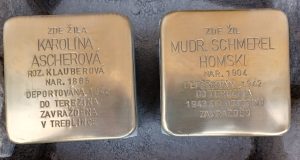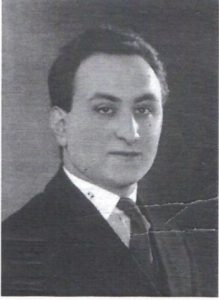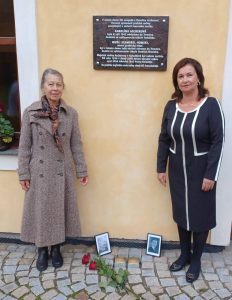 Address: K JÍZDÁRNĚ 9/20, PRAHA 9
Address: K JÍZDÁRNĚ 9/20, PRAHA 9
Born 25. 07. 1904
Last residence before deportation: Koloděje
Address/place of registration in the Protectorate: Uhříněves
Transport Bg, no. 509 (12. 09. 1942, Prague -> Terezín)
Transport Dn/a, no. 16 (05. 10. 1943, Terezín -> Auschwitz)
Murdered
 Born in Hînceşti in what is now Moldova, Schmerel Homski studied at the Gymnasium in Kishinev and the Faculty of Medicine at the Charles University in Prague, from which he graduated in June 1937. It is likely that after graduation, he intended to return to his homeland, but was thwarted by the political developments in Europe. The register of Charles University doctors shows that MUDr. Schmerel Homski renounced the right to practice medicine in Czechoslovakia.
Born in Hînceşti in what is now Moldova, Schmerel Homski studied at the Gymnasium in Kishinev and the Faculty of Medicine at the Charles University in Prague, from which he graduated in June 1937. It is likely that after graduation, he intended to return to his homeland, but was thwarted by the political developments in Europe. The register of Charles University doctors shows that MUDr. Schmerel Homski renounced the right to practice medicine in Czechoslovakia.
However, fate willed otherwise and Schmerel is next recorded as living in Karolína Ascherová’s house in Koloděje and running a medical practice in the adjacent house, No. 69. According to the Koloděje memoirs, this was accessed through a door in the gable of the house opposite the Kaucky farmhouse (now the seat of the Science 21 Foundation). The Koloděje memoirs record that the doctor was very popular in the village and that he did not charge the poor for treatment. Schmerel’s connection with the Aschers is still a mystery, I have not been able to trace any reference to it and even the Ascher descendants know nothing about Schmerel Homski. It seems that Mrs. Ascherová simply gave Dr. Homski asylum in difficult times, in a “forgotten” village.
On September 8th 1942, doctor Schmerel Homski was transported to Terezín, where he was assigned to a 53 person team charged with the care of 1,196 decimated orphans. The children had been brought from the Bialystok ghetto in late August 1943 and were probably in poor mental and physical condition after all they had experienced in Poland. They were housed far from the other prisoners, in the Terezín barracks known as Kréta. Contact between these children or their caretakers and other prisoners was prohibited on pain of death. Their presence was shrouded in secrecy. The men and women carers were mostly either doctors or nurses. Franz Kafka’s sister and nurse, Otilie David (29 October 1892–5 October 1943) was amongst them.
For a while the fate of these 1,196 children from the Bialystok ghetto and their guardians looked promising. The English government expressed its intention to organize their rescue, and everyone, including the prisoners, believed that they would be taken by train to Palestine or Switzerland and liberated. However, in reality, the German officials had no intention of dealing with them any differently than other Jewish prisoners. The reason for keeping them in Terezín, was a plan to engage in deceptive negotiations aimed at securing the release of interned Germans. Only after the war did the truth come to light. On October 5, 1943, a transport of children left Terezín, traveled east and arrived in Auschwitz on October 7. All were herded from the train straight into the gas chambers. The tragic fate of these children was shared by their 53 guardians, including MUDr. Schmerel Homski.
